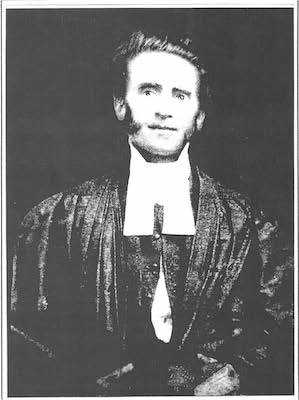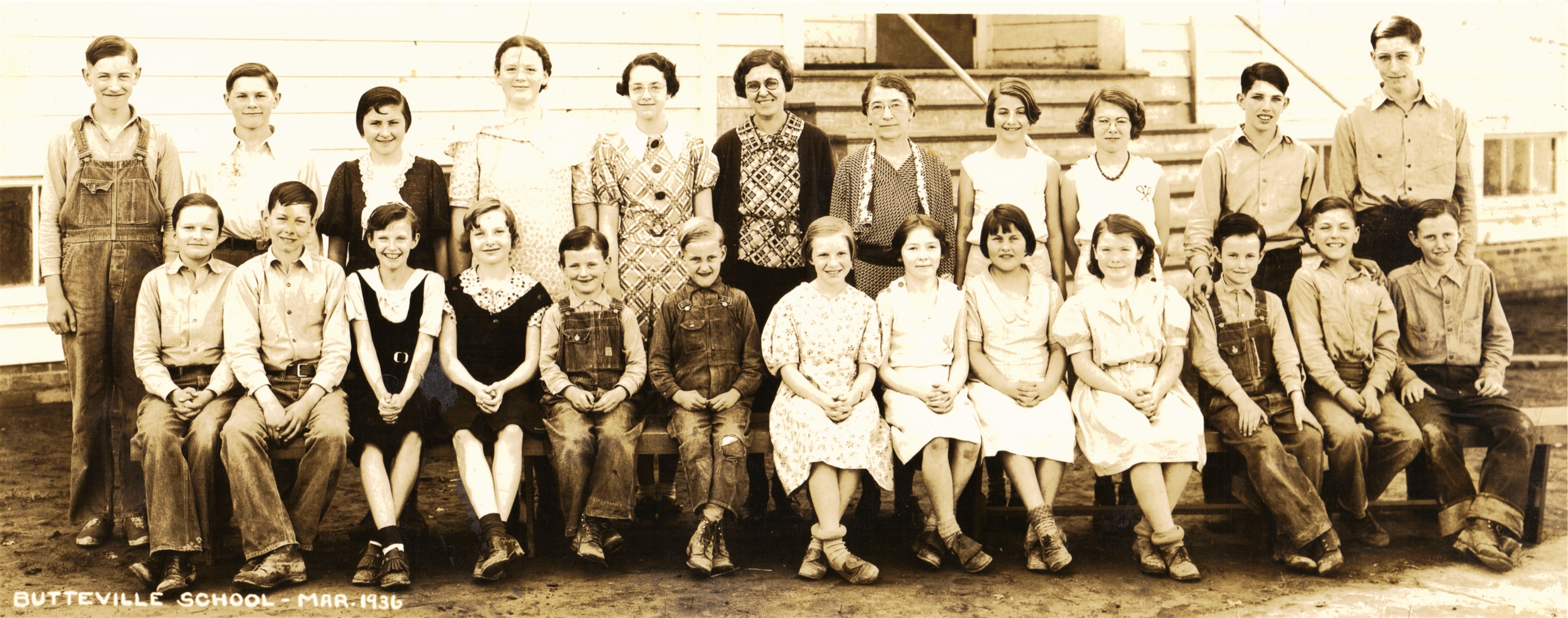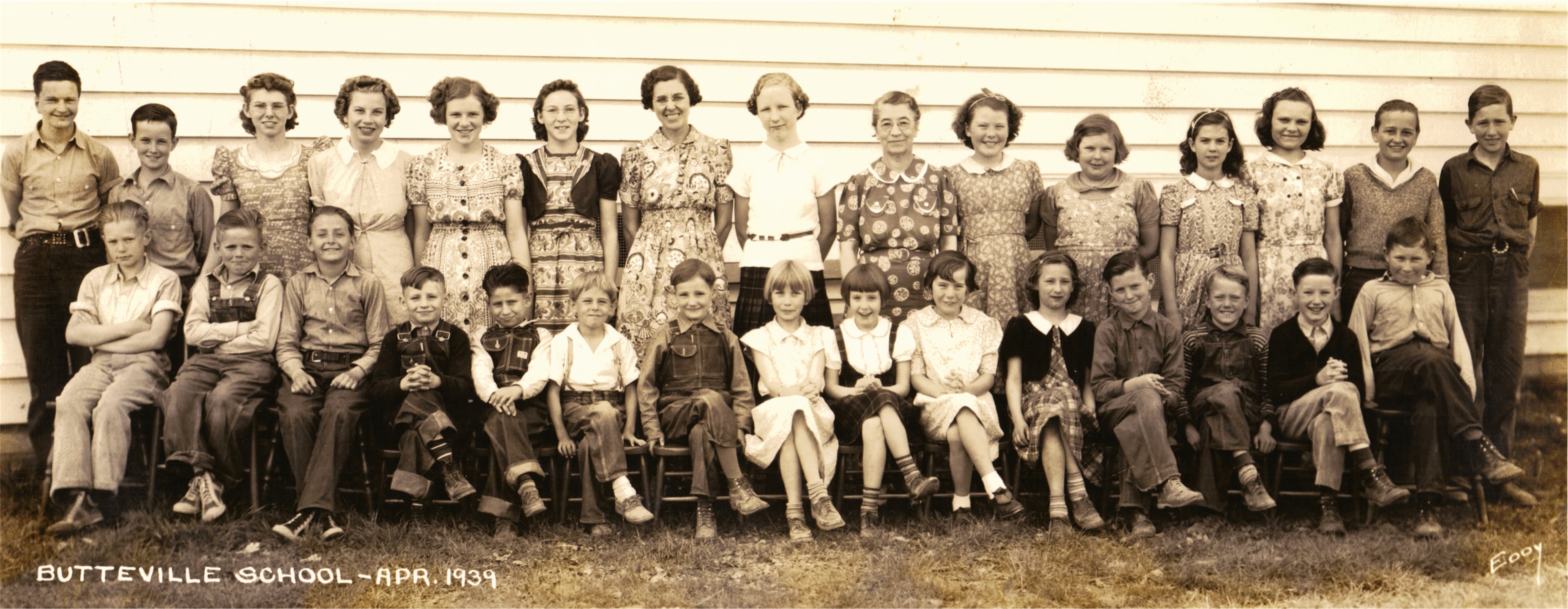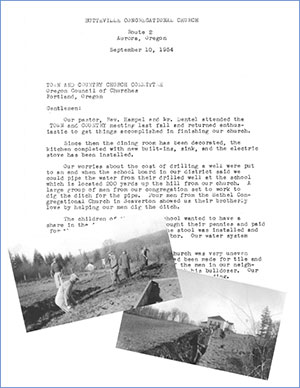A Short History of Schools in Butteville
The history of the “school” in Butteville is complicated and difficult to map with precision. What is typically implied in questions or comments about the early or first school in Butteville is that it was a public school. Further whether public or not there is mixed terminology referring to the school as the “Butteville Institute” and sometimes the “Butteville Academy.” What we can ascertain is that there were two different types of schools in Butteville, and some of the common assumptions about these schools are incorrect.
Original School
Rob Forrest, in his unpublished article Butteville[1] states that “there was a school building erected at Butteville about 1860, the upper portion being used as a lodge room and the lower part for school. S.W. King, afterward superintendent of schools in Portland, taught there.” What, however, was that school, and who built it?
The “History of the Diocese of Oregon” states that “The first recorded service using the American Book of Common Prayer in the Pacific Northwest, was in Oregon City, December 1, 1847, when The Rev. St. Michael Fackler baptized James McKinlay, son of Archabald and Julia Ogden McKinlay and grandson of Peter Skene Ogden.” It then goes on to describe the parishes that Rev. Fackler established and states that “In 1852, another congregation, Incarnation, Butteville, was organized.”[2]
The Biography of Rev. St. Michael Fackler[3] describes him crossing the plains in 1847, teaching for a short time at the Methodist School in Salem, then “At an early day he secured a farm not far from Butteville, where he resided for a number of years. While thus occupied in secular affairs he was not idle as a clergyman; for he spent his Sundays in holding services at Champoeg, Butteville, Stringtown, Oregon City, Portland and on the Tualatin Plains.
In the course of time he fitted up a schoolhouse at Champoeg for services and built a neat little church at Butteville, doing most of the work with his own hands. It was the day of small things then, and those who knew anything of the Episcopal church were very few indeed.”
So, we can deduce from this that Rev. Fackler was a craftsman of sorts and know how to farm, and understood the need for buildings: both for schools and worship. Additionally, he was a missionary priest who came to Oregon of his own volition, and founded a few churches. He is listed in the 1859 Journal of the General Convention of the Protestant Episcopal Church in the Unites States as the Priest located in “Butteville, O.T. (Oregon Territory).”
Since at this time a very real competition was raging between Champoeg and Butteville to be the ascendant community in north French Prairie on the Willamette River, and we know Fr. Fackler was serving both communities as well as others, it is likely he built a “dual purpose” structure in both places: one that could serve as school during the week, and for worship on Sunday.
The flood of 1861 washed the town of Champoeg away, and while Butteville was damaged it survived due to its higher elevation. Fr. Fackler moved to and founded the first church ever in Boise, Idaho, in 1864. According to Samuel Clemons (aka: Mark Twain), in the Grim Voyage, Fr. St. Michael died of cholera aboard a steamer the San Francisco at Key West, Florida, on January 6, 1867, while on a trip to New York. We have no record of a replacement priest being assigned to replace Rev. Fackler in the churches he founded.
Of note is that the 1878 map of North Marion County includes a plat map of the town of Butteville, and it includes an Episcopal Church (referenced as number 1). Also of note, it shows a “Public School.” This is where the confusion about the first “school” comes from, in as much as Fr. Fackler was an Episcopalian priest and the building that he constructed served both as a parish church and as a school.
The public school shown on the 1878 map is the first “public” school: it was the union district school in School District No. 57, under the State Department of Education, located on Block 9 of the plat map, which shows ownership by the School District in 1861. In 1862 the Masons leased the upper level of the building for their meetings.

No 1 on the Butteville plat map is an Episcopal Church; No. 2 is a dual purpose Public School/Masonic Hall & Odd Fellows Hall
Beyond these materials, the earliest other reference to the school of Butteville is found in the 1884 Oregon, Washington & Idaho Gazeteer and Business Listing, which lists a “church” and a “district school” along with a post office and a full time postmaster.
Again, church and “public school” are listed separately as on the 1878 map. The 1884 Gazeteer listing shows that the Rev. Fackler’s privately-built “public” school has been replaced by a “district school,” within a Union School District under the State Department of Education.” The 1878 plat map also points us to a school location above 2nd Street in the old part of building that is now a private residence.
We can document from the original Butteville Community Church ledger that this church, which is still extant and thriving, was originally organized November 9, 1891 as the Congregational Church of Christ in Butteville, and recognized by the Congregational Church Council on April 13, 1892. This is clearly a different and later church in Butteville and not Rev. Fackler’s Episcopal Church.
Summary
From the foregoing we can deduce that the “original” school in Butteville was Rev. Fackler’s “school” which was likely dual purpose with the original located on French Street facing the river. This then is likely what is often referred to as the “Butteville Academy.” Given no record of Rev. Fackler being replaced, we do not know specifically how the building was used after his departure, but by the early to mid-1900’s it had been relocated to the southwest corner of Butte and 1st Streets, diagonally across the street from the current Butteville Store.
In 1957 the building was relocated to the Newell House Museum at Champoeg along with the Butteville jail. It is frequently referred to as the “original Butteville school,” but appears to be Rev. Fackler’s religious school, not the first “public school” referenced in either the 1878 plat map or the Gazeteer listing of 1884.
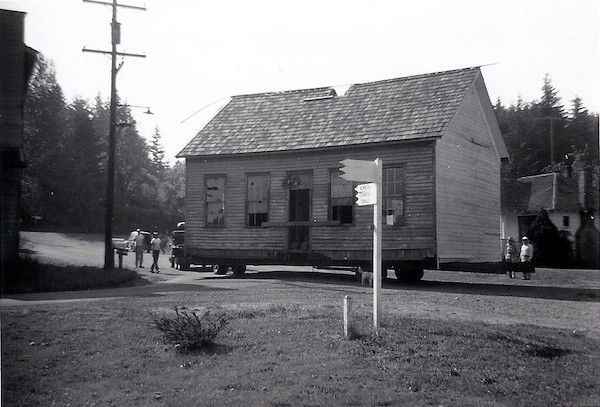
Original Butteville School building, originally located on French St. between Main St. and the river, parked at the corner of Butte and 1st Streets and ready to be moved to the Newell House Museum in 1957
Butteville Institute & The First Public School
In November 1859, Butteville Institute was incorporated by an act of the State Legislature. Francis X. Matthieu was listed as a trustee, with eight others: George L. Curry, G. A. Cone, George Hibler, Ely Cooley, J. W. Grimm, F .J. Geer, and J.C. Geer. There is no record that the Butteville Institute was ever built and opened its doors, but it does appear that the School District acquired the Block 9 property and that the building on that property served as the “public school.”
In Clark's History of the Willamette Valley, he refers to the first school as follows: “Butteville institute was chartered January 20, 1859, its trustees being G.L. Curry, Ely Cooley, G.A. Cone, J.vi. Grim, A.R. Dimie, Geo. Hibler, F.\1·. Geer, F.X. Mattieu, Joseph Carey, Geer and George La.Rocque." J.W. Grim was authorized to call the first meeting at Butteville. Section 10 of the charter provided that no political or religious qualifications for officers or teachers should be required. "Nor shall more than one fourth of the trustees, at one time, belong to the same religious denomination." [4]
Again, it is uncertain whether the Butteville Institute organization resulted in the construction of a school building—it is most likely that it resulted in the acquisition of property and operated in an existing building (most likely originally built as a home) that was referred to as the “old Josie Ryan” home on the hill in Block 9 above the Butteville Store. This make sense because JJ Ryan owned Block 10 directly to the east across Arndt Road where he lived. However, the action by the State Legislature confirms this was a school under the State Department of Education: i.e. a school within a State union school district. That fact is confirmed in the documents from May 1949 where a motion to dissolve the union school districts in Butteville, Donald, Aurora, White and Broadacres failed and the schools in those communities remained under the State Department of Education (as opposed to moving into the County public school district).[5]
Rob Forest documents the following from interviews with local residents in the 2000 to 2005 time frame: “The. school building remembered best by many of those present is the old Josie Ryan, Jr.. residence on the hill overlooking Butteville and facing Ladd Hill across the river. The names of many teachers will be kindly remembered. Some of those recalled are. May Clark, Irven Carter, 0.H. Byland, Metta Matthieu, H.L. Bentz. Among the most outstanding were Sam King and Walter Tooze, Sr. Mr. Tooze taught in the year 1866.”
This description ties to the building indicated as No. 2 in Block 9 on the 1878 plat map, which lists in this position on the hill BOTH a public school and the combined Masonic & Odd Fellows Hall. We know that Rev. Fackler was in Boise by 1864 and do not know if anyone continued teaching school in his religious building, nor do we have any knowledge of transfer of ownership other than the listing on the 1878 plat map as an “Episcopal School.”

View down 2nd Street (looking southwest in 1914), showing the two story Josie Ryan home on the hill and facing Ladd Hill, that served as a district school in the late 1800s.
Rob Forest’s interview continues: “In 1894 a new school was erected on the hill at a cost of $4,000. It was an ornate and handsome two-story building typical of the architecture of its day. The directors were H.L. Bentz, Joseph Scheurer, and John Murray. There were between 45 and 50 students in the new school when it opened, and 0.H. Byland was the teacher. He was paid $50.00 per month. Familiar names of teachers include Clara Demmer, Retta Dawson, A.L. Briggs, Clara Hines, Miss Hay, Mr. Hartson, Ar. Springer, and Etta Iler.”
“On the hill” here means a new location further up the hill, not on the original district school location on Block 9. The question, then, is if any evidence exists to tie together the “public school” indicated on the 1878 plat map and the 1884 Gazeteer listing with this photo and the recollections of older residents shortly after 2000.
In fact, there is.

The photo archives of the Oregon Historical Society contain an image of a drawing by a child named “Johnny Vaugh” or “Johnny Vaughn” of the Butteville School House – 1884.
The architecture of the building in the drawing and that of the house above 2nd Street in the photo above are very similar and would appear to definitively link the two. This school, then, was the first public school in Butteville—it being a union district school under the State Department of Education. This building (remodeled and expanded) is now a private residence.
Because early historical documents designate this first non-religious school as a “public school” we will refer to this and the subsequent schools in Butteville as such, recognizing that technically they were “district schools” within State School District No. 57.
The Second Butteville Public School
We have two photographs of the new public school erected in 1894 for the sum of $4,000, and its architecture matches the description given by Rob Forest in his article. This Public School was in a new location up the hill on the east side of Arndt Road, a little south of the Butteville Community Church.

The 2nd Butteville Public School, which opened in 1894.
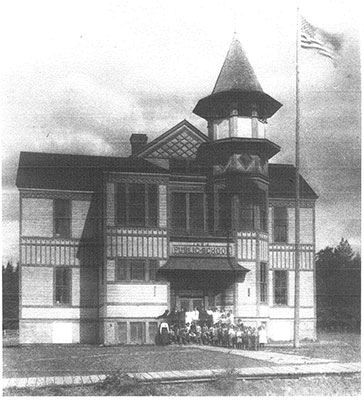
Butteville School 1908 front photo.
The Butteville Public School was a thriving institution, drawing students from the Butteville District of French Prairie, as evidenced by this photo of the Butteville School Reunion in 1912:
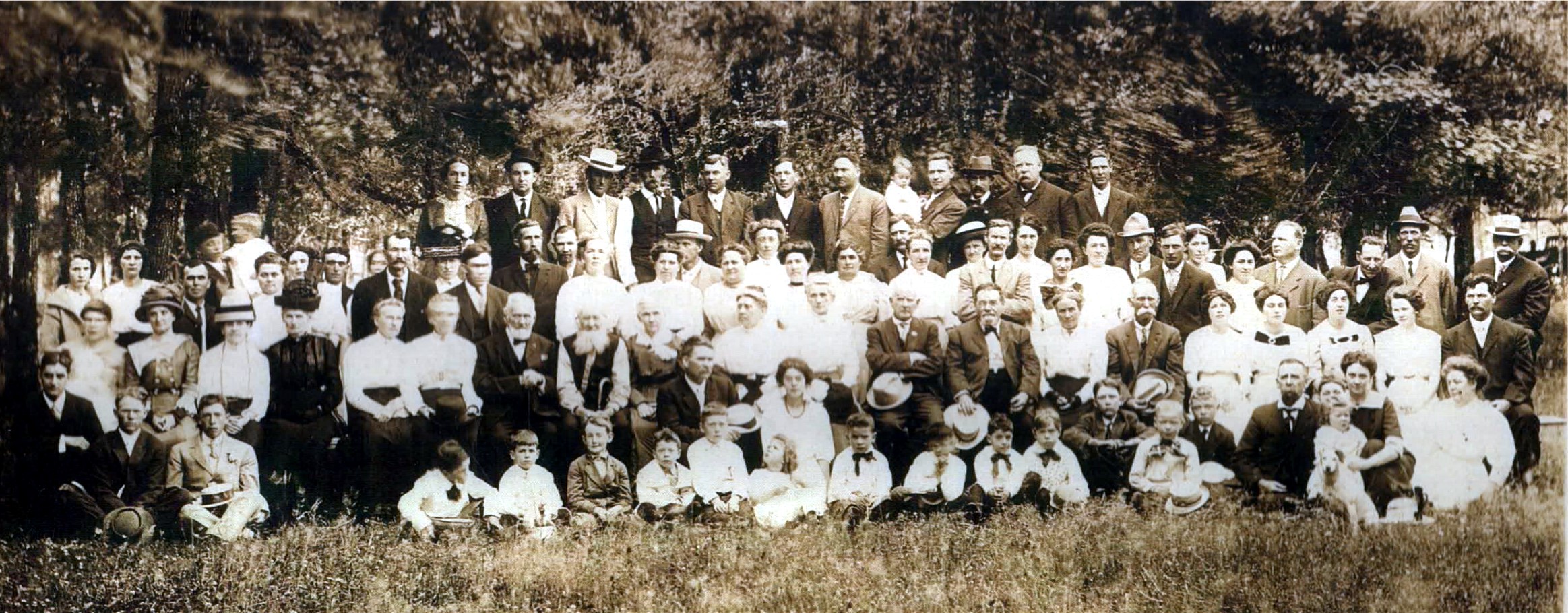
Photo from collection of Edith Crissell Torgeson.
CLASS PHOTOS
1933, 1936 & 1939 Photos courtesy Kathy Wilmes Layton; 1940 & 1942 courtesy estate of Virginia Bowman
Community at work
On Mother’s Day, May of 1946, the original Butteville Community Church burned and was a complete loss. In 1948 the new Butteville Church was dedicated, but it had no water and the church did not have the funds to drill a well. Over the course of the next six years the interior of the church building was finished, then the basement was finished and a kitchen put in, but the church still could not afford to drill a well. Then the breakthrough: in September of 1954 the School Board of the Butteville School approved providing water to the Butteville Church from the school’s well. What commenced was the Butteville Church “water project” to hand dig a pipe trench from the school, 200 yards down the hill and under Arndt Road to provide water to the Butteville Church.
The Third Butteville Public School
After the second school burned, a replacement and more modern school was erected on the same site. The third Butteville Public School is now a private residence, and operated as Butteville’s public school until 1959 when schooling was transferred to the North Marion School District.
Consolidation into North Marion School District
Butteville Public School comprised the Butteville District within Union School District No. 6, under the State Department of Education, along with adjoining districts such as Aurora, Donald, White, Hubbard, Broadacres, etc. In Sept. 1948 an effort was made to dissolve the Union High School District under the State Board, and form a new local North Marion School District. That effort failed by a narrow margin, but in the late 1950’s it succeeded.[5]
The Record Book for Butteville for 1958-59 confirms then, that the Butteville Union School District continued until at least that school year, and that thereafter the school became part of North Marion School District. That correlates with oral history that the second public school in Butteville operated until 1958 or so.
Students Listed in the School Register & Record Book for Butteville School
| School Year 1958-59 | |
|---|---|
| Armstrong, Kay Lynn – Grade 1 | Bertrand, Charles – Grade 5 |
| Koenig, Sharon Leigh – Grade 1 | Johnson, Andrew – Grade 5 |
| Bradbury, Howard – Grade 2 | Johnson, Bessie – Grade 5 |
| Hubbard, Marcia Ann – Grade 2 | Pahl, Edward – Grade 5 |
| Miller, Anita – Grade 2 | Racette, Martha – Grade 5 |
| Misteldt, Peggy Ann – Grade 2 | Smith, Edward – Grade 5 |
| Racette, , Carol Faye – Grade 2 | White, Allen – Grade 5 |
| Kosta, Richard – Grade 2 | Arested, Joyce – Grade 6 |
| Armstrong, Harold – Grade 3 | Hubbard, Mike – Grade 6 |
| Jones, Janice M – Grade 3 | Jones, Gary – Grade 6 |
| Misteldt, Flora F. – Grade 3 | Martin, Noel – Grade 6 |
| Misteldt, Norene – Grade 3 | Pahl, Jonathan – Grade 6 |
| Pahl, Glenda M – Grade 3 | Schulte, Karen – Grade 6 |
| Pahl, Jennifer – Grade 3 | Tautfest, Russell Jr. – Grade 6 |
| Racette, Linda – Grade 3 | Taylor, Dennis E. – Grade 6 |
| Racette, Richard – Grade 3 | Bradbury, Janet – Grade 7 |
| Wilmes, Dennis W. – Grade 3 | Racette, Kenneth – Grade 7 |
| Arested, Thomas – Grade 4 | Riley, Gene – Grade 7 |
| Armstrong, Stanley – Grade 4 | Shannon, Mike – Grade 7 |
| Bertrand, Williams – Grade 4 | Bertrand, James – Grade 8 |
| Bradbury, Rhonda – Grade 4 | Gilligan, Gary – Grade 8 |
| Jones, Carla – Grade 4 | Johnson, Timm – Grade 8 |
| O’Dell, Robert – Grade 4 | Martin, Nicki – Grade 8 |
| Wilmes, Margaret – Grade 4 | Smith, Kenneth – Grade 8 |
| Hershberger, Steven – Grade 4 | Stewart, Mona – Grade 8 |
| Armstrong, Margaret – Grade 5 | Hershberger, Ken – Grade 8 |
| Teachers listed for the 1958-59 School Year-59 | |
| Mrs. Bettie Peters | Mrs. Leona Wilson |
| Mr. Lynne W. Sands | |
At the end of the 1959 school year, the third Butteville Public School property was sold and became a private residence.
Download
You may down this history in PDF format.
Short History of Schools in Butteville
Prepared by Friends of Historic Butteville. Please send any corrections and any additional history material available to us for inclusion.
Version 1.1 – Feb. 3, 2020
[1] Butteville is a self-published short history of the community of Butteville that focuses on schools in the community. It was assembled and published while Rob Forrest and his wife operated the Butteville Store in the early 2000’s.
[2] History of the Diocese of Oregon; The Episcopal Church in Western Oregon
[3] Collection: History of the Pacific Northwest Oregon and Washington. 2 v. Portland, Oregon: North Pacific History Company. 1889.
[4] History of the Willamette Valley, Robert Carlton Clary, S.J. Clarke Publishing Company, Chicago 1927
[5] Notice to School Boards from Agnes C. Booth, Secretary, Marion County District Boundary Board
